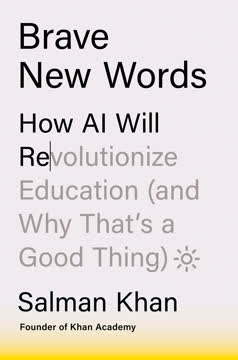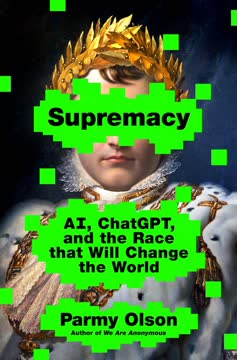Key Takeaways
1. Complex decisions require full-spectrum analysis across multiple disciplines
If we had a keen vision and feeling of all ordinary human life, it would be like hearing the grass grow and the squirrel's heart beat, and we should die of that roar which lies on the other side of silence.
Multidimensional approach. Complex decisions involve numerous interacting variables across various scales of human experience. From intimate emotional responses to broader societal trends, a full-spectrum analysis considers:
- Personal factors: emotions, values, goals
- Social dynamics: relationships, community impact
- Economic considerations: financial implications, market trends
- Technological influences: current and future advancements
- Historical context: past precedents and long-term consequences
By integrating insights from diverse fields such as psychology, economics, sociology, and technology, decision-makers can develop a more comprehensive understanding of the challenges they face.
2. Mapping the decision landscape reveals hidden variables and options
One thing a person cannot do, no matter how rigorous his analysis or heroic his imagination, is to draw up a list of things that would never occur to him.
Cognitive mapping techniques. To uncover hidden variables and potential paths, effective decision-makers employ various mapping strategies:
- Influence diagrams: Visual representations of decision factors and their relationships
- Stakeholder analysis: Identifying and considering all affected parties
- Expert roles: Assigning specialized knowledge areas to team members
- Hidden profiles: Surfacing unique information held by individuals
These techniques help overcome cognitive biases and reveal previously unconsidered options. By thoroughly exploring the decision landscape, individuals and organizations can identify innovative solutions and avoid overlooking critical factors.
3. Simulations and scenario planning enhance predictive capabilities
What theory or science is possible where the conditions and circumstances are unknown . . . and the active forces cannot be ascertained?
Forecasting methods. Decision-makers can improve their ability to anticipate future outcomes through various simulation and scenario planning techniques:
- Ensemble forecasting: Running multiple simulations with slight variations in initial conditions
- War games: Role-playing exercises to explore potential conflicts and strategies
- Scenario planning: Developing multiple plausible future narratives
- Premortems: Imagining potential failures before they occur
These approaches allow decision-makers to explore a wide range of possible outcomes and prepare for unexpected contingencies. By simulating different scenarios, individuals and organizations can develop more robust strategies and identify potential pitfalls before committing to a course of action.
4. Diverse perspectives and challenging assumptions improve decision quality
To derive the most useful information from multiple sources of evidence, you should always try to make these sources independent of each other.
Cognitive diversity. Incorporating diverse viewpoints and actively challenging assumptions leads to better decisions:
- Red teaming: Assigning a group to play devil's advocate and critique plans
- Design charrettes: Collaborative sessions bringing together various stakeholders
- Cognitive peripheral members: Seeking input from those with unique perspectives
- Challenging the status quo: Actively questioning established beliefs and practices
By fostering an environment that encourages diverse thinking and constructive dissent, decision-makers can uncover blind spots and develop more innovative solutions. This approach helps counteract groupthink and reduces the risk of overlooking critical information.
5. Embracing uncertainty and flexibility leads to more robust choices
Uncertainty today is not just an occasional, temporary deviation from a reasonable predictability; it is a basic structural feature of the business environment.
Adaptable strategies. Recognizing the inherent uncertainty in complex decisions allows for more flexible and resilient approaches:
- Cone of uncertainty: Acknowledging the range of possible outcomes
- Downstream flexibility: Favoring choices that allow for future modifications
- Minimally viable decisions: Starting with smaller, reversible steps
- Measuring uncertainty: Explicitly rating confidence levels in predictions
By embracing uncertainty and building adaptability into decision-making processes, individuals and organizations can better navigate unpredictable environments and respond effectively to changing circumstances.
6. Literature and storytelling provide valuable decision-making insights
Stories, as Tooby and Cosmides put it, mean we "are no longer limited by the slow and unreliable flow of actual experience. Instead, we can immerse ourselves in the comparatively rapid flow of vicarious, orchestrated, imagined, or fictional experience."
Narrative wisdom. Literature and storytelling offer unique benefits for decision-making:
- Empathy enhancement: Developing a deeper understanding of others' perspectives
- Mental simulation: Exploring hypothetical scenarios and their consequences
- Full-spectrum narratives: Examining decisions across multiple scales of human experience
- Cultural insights: Gaining awareness of historical and societal contexts
By engaging with literature and storytelling, decision-makers can broaden their understanding of human nature, develop their empathetic abilities, and explore complex scenarios in a low-stakes environment. This narrative approach complements more analytical decision-making tools.
7. Farsighted decisions shape the long-term future of individuals and society
We are as gods. We might as well get good at it.
Long-term thinking. Farsighted decisions have the power to shape individual lives and societal trajectories:
- Personal choices: Career paths, relationships, and life goals
- Organizational strategies: Long-term business planning and innovation
- Societal decisions: Environmental policies, technological development, and cultural shifts
By cultivating the ability to make farsighted decisions, individuals and societies can:
- Anticipate and prepare for future challenges
- Create more sustainable and resilient systems
- Navigate complex global issues with greater wisdom
Developing farsighted decision-making skills is crucial for addressing the increasingly complex challenges of the modern world and creating a positive long-term future.
Last updated:
FAQ
What's Farsighted: How We Make the Decisions That Matter the Most about?
- Focus on Decision-Making: The book delves into how humans make complex decisions, especially those with long-term impacts. It highlights the importance of foresight in decision-making.
- Historical and Modern Examples: Steven Johnson uses examples like the fate of Collect Pond and the hunt for Osama bin Laden to illustrate effective decision-making principles.
- Frameworks and Techniques: The book introduces frameworks such as mapping, predicting, and scenario planning to enhance decision-making skills.
Why should I read Farsighted by Steven Johnson?
- Enhance Decision-Making Skills: Gain practical insights and techniques to improve decision-making in personal and professional contexts.
- Learn from History: Historical decisions provide lessons on the consequences of poor decision-making and the value of multiple perspectives.
- Interdisciplinary Approach: The book draws from psychology, economics, and environmental science, making it relevant to a wide audience.
What are the key takeaways of Farsighted?
- Long-Term Thinking: Effective decision-making requires considering long-term implications rather than just immediate outcomes.
- Diversity in Decision-Making: Engaging diverse perspectives leads to more comprehensive and effective decision-making processes.
- Utilizing Tools and Frameworks: Methods like influence diagrams and scenario planning help visualize and analyze complex decisions.
How does Farsighted address the concept of "bounded rationality"?
- Understanding Bounded Rationality: Decision-makers often face constraints of limited information and cognitive biases.
- Strategies to Overcome Limitations: Structured decision-making frameworks and collaborative approaches can mitigate these effects.
- Real-World Implications: Acknowledging these limitations helps individuals prepare for complex decisions and improve outcomes.
What is the "moral algebra" mentioned in Farsighted?
- Concept of Moral Algebra: A systematic approach to weighing pros and cons, akin to Benjamin Franklin's method.
- Balancing Factors: Involves assessing the relative importance of factors for a nuanced understanding of decisions.
- Application in Decision-Making: Encourages deeper reflection to avoid rash decisions based on superficial analysis.
What specific methods does Farsighted recommend for decision-making?
- Linear Value Modeling (LVM): Evaluates options based on weighted values, quantifying the importance of different factors.
- Premortems: Envision potential failures before making a choice to identify risks and encourage proactive planning.
- Red Teaming: Challenges assumptions and explores alternative perspectives to enhance critical thinking.
How does Farsighted define "superforecasting"?
- Concept of Superforecasting: References Philip Tetlock's research on individuals who make accurate predictions about future events.
- Traits of Superforecasters: Open-mindedness, willingness to consider multiple perspectives, and adaptability to new information.
- Application in Decision-Making: Adopting superforecasters' mindset and techniques can enhance informed decision-making.
What role does storytelling play in decision-making according to Farsighted?
- Narrative as a Tool: Helps visualize potential outcomes and understand decision implications more clearly.
- Scenario Planning: Crafting narratives around potential futures allows exploration of various paths and consequences.
- Emotional Engagement: Stories engage emotions, making decision-making more relatable and impactful.
What are some examples of decisions discussed in Farsighted?
- Bin Laden Raid: Analyzes the decision-making process behind the raid, illustrating complexities of high-stakes military decisions.
- Darwin's Marriage Choice: Explores Charles Darwin's internal struggle regarding marriage and its implications for his work.
- Collect Pond's Destruction: Examines the long-term environmental consequences of filling in Collect Pond in New York City.
How does Farsighted relate to modern decision-making challenges?
- Addressing Uncertainty: Provides strategies for navigating uncertainty, encouraging readers to embrace complexity.
- Long-Term Thinking: Emphasizes the importance of considering long-term impacts, crucial for addressing global issues.
- Diversity in Decision-Making: Advocates for incorporating diverse perspectives, essential in a globalized world.
What role does empathy play in decision-making according to Farsighted?
- Understanding Others: Empathy is vital for understanding perspectives of those affected by decisions, fostering informed choices.
- Building Consensus: Helps build consensus among stakeholders, facilitating complex group decisions.
- Enhancing Foresight: Empathetic decision-making enhances foresight by anticipating emotional reactions of others.
What are the best quotes from Farsighted and what do they mean?
- “What happens fast is illusion, what happens slowly is reality.”: Emphasizes thoughtful decision-making over rushing into choices.
- “The clarity of that formula... necessarily grows cloudy when confronted with actual decisions.”: Reflects on challenges of applying theoretical frameworks in real-life situations.
- “We should want our leaders... to show that same willingness to slow down the decision.”: Advocates for deliberate leadership and thorough analysis before making impactful choices.
Review Summary
Farsighted explores decision-making processes for complex, long-term choices. Johnson presents a framework of mapping options, predicting outcomes, and deciding based on weighted criteria. He uses diverse examples, from military operations to personal decisions, emphasizing the importance of considering multiple perspectives and simulations. While some readers found the book insightful and well-researched, others felt it lacked novelty or became unfocused towards the end. Many appreciated Johnson's storytelling ability and his argument for reading literary fiction to improve decision-making skills.
Similar Books










Download PDF
Download EPUB
.epub digital book format is ideal for reading ebooks on phones, tablets, and e-readers.












